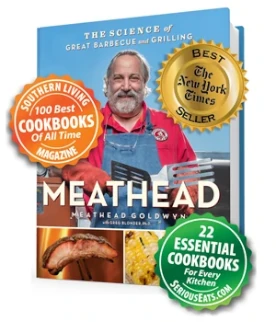I remember back in the day when people (my Mom was one of them) tried cooking holiday turkeys or large roasts overnight at very low (below 200°) oven temperatures and a spate of articles about food safety of a slowly heating bird or roast came to light. I'm wondering if using very low temperatures for very long times in a smoker for meat and poultry has also been brought under scrutiny?
Note: I'm not talking about cold smoking here. Meathead has written extensively about food safety and cold smoking.
I went a-googling and found several articles that discuss food safety at low and slow BBQ temperatures. I had a hard time, though, finding one that was scientific enough for my tastes--one that came from reputable food safety experts.
This is a thoughtful article on the subject: https://www.totallysmokin.com/4-hour-rule-smoking/ , although it erroneously states that pathogens generated in the danger zone are killed when the food is taken to a higher temperature during the cook. This article also discusses the Intact Muscle Rule with respect to food safety.
I can only speak from my own experience. When I smoke meats (usually at 250°ish or higher), the thicker cuts like briskets and chuck roasts stay in the danger zone between 1-2 hours, usually. Thinner cuts zip through the danger zone even faster. Whole birds like turkey also zip through the danger zone because I smoke them at 350° or higher.
Two situations come to mind where meat might stay in the danger zone for longer than 4 hours during a routine smoke/cook.
1. Overnight or otherwise unattended cooks where the smoker temperature dips low.
2. Pellet cookers run for long periods of time on the Smoke setting.
It seems as though, for certain combinations of smoker temperatures and meat thickness, that the meat could stay for a long time in the danger zone of 40° to 140°, exceeding the FDA-recommended 4-hour window at these temps. Should that be of concern?
For those of us who have remote thermometers with food and ambient temperature graph capability, it's easy to check to see how long the danger zone lasts during a cook. That always eases my mind, since time spent in the danger zone is apparently cumulative for any given food.
Kathryn
Note: I'm not talking about cold smoking here. Meathead has written extensively about food safety and cold smoking.
I went a-googling and found several articles that discuss food safety at low and slow BBQ temperatures. I had a hard time, though, finding one that was scientific enough for my tastes--one that came from reputable food safety experts.
This is a thoughtful article on the subject: https://www.totallysmokin.com/4-hour-rule-smoking/ , although it erroneously states that pathogens generated in the danger zone are killed when the food is taken to a higher temperature during the cook. This article also discusses the Intact Muscle Rule with respect to food safety.
I can only speak from my own experience. When I smoke meats (usually at 250°ish or higher), the thicker cuts like briskets and chuck roasts stay in the danger zone between 1-2 hours, usually. Thinner cuts zip through the danger zone even faster. Whole birds like turkey also zip through the danger zone because I smoke them at 350° or higher.
Two situations come to mind where meat might stay in the danger zone for longer than 4 hours during a routine smoke/cook.
1. Overnight or otherwise unattended cooks where the smoker temperature dips low.
Every now an then pitmaster posts a question here about the food safety of a cook like this. Advice usually focuses on the specifics of the cook.
2. Pellet cookers run for long periods of time on the Smoke setting.
I don't have a pellet cooker, but it's my understanding that, for long cooks, they are often run for a period of time at a low temperature initially to increase smoke absorption in the cold meat. Someone correct me if I'm wrong here. Is there an upper limit to how long a piece of meat can or should be cooked at this very low temperature (below 200°, for example) in a pellet cooker?
It seems as though, for certain combinations of smoker temperatures and meat thickness, that the meat could stay for a long time in the danger zone of 40° to 140°, exceeding the FDA-recommended 4-hour window at these temps. Should that be of concern?
For those of us who have remote thermometers with food and ambient temperature graph capability, it's easy to check to see how long the danger zone lasts during a cook. That always eases my mind, since time spent in the danger zone is apparently cumulative for any given food.
Kathryn










Comment